
Musca is a small constellation in the deep southern sky. It was one of 12 constellations created by Petrus Plancius from the observations of Pieter Dirkszoon Keyser and Frederick de Houtman, and it first appeared on a celestial globe 35 cm (14 in) in diameter published in 1597 in Amsterdam by Plancius and Jodocus Hondius. The first depiction of this constellation in a celestial atlas was in Johann Bayer's Uranometria of 1603. It was also known as Apis for 200 years. Musca remains below the horizon for most Northern Hemisphere observers.

Musca Borealis was a constellation, now discarded, located between the constellations of Aries and Perseus. It was originally called Apes by Petrus Plancius when he created it in 1612. It was made up of a small group of stars, now called 33 Arietis, 35 Arietis, 39 Arietis, and 41 Arietis, in the north of the constellation of Aries.
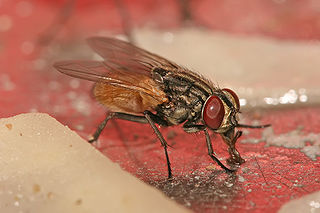
Muscidae are a family of flies found in the superfamily Muscoidea.
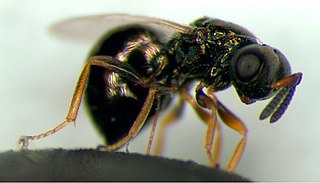
. یکی از چهار گونه شناخته شده از جنس ناسونیا می باشد گونه

Musca is a genus of flies. It includes Musca domestica, as well as Musca autumnalis. It is part of the family Muscidae.
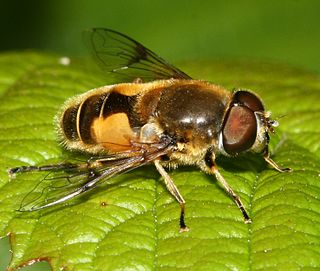
Eristalis horticola is a Palearctic species of hoverfly.

The housefly is a fly of the suborder Cyclorrhapha. It is believed to have evolved in the Cenozoic Era, possibly in the Middle East, and has spread all over the world as a commensal of humans. It is the most common fly species found in houses. Adults are gray to black, with four dark, longitudinal lines on the thorax, slightly hairy bodies, and a single pair of membranous wings. They have red eyes, set farther apart in the slightly larger female.
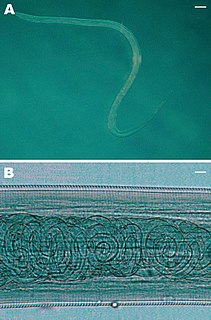
Thelazia is a genus of nematode worms which parasitize the eyes and associated tissues of various bird and mammal hosts, including humans. They are often called "eyeworms", and infestation with Thelazia species is referred to as "thelaziasis". Adults are usually found in the eyelids, tear glands, tear ducts, or the so-called "third eyelid". Occasionally, they are found in the eyeball itself, either under the conjunctiva or in the vitreous cavity of the eyeball. All species of Thelazia for which the life cycle has been studied are transmitted by species of Diptera (flies) which do not bite, but which feed on tears.
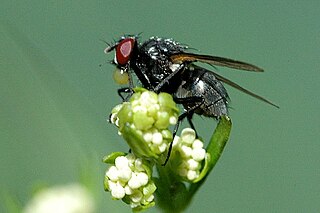
Hydrotaea is a genus of insects in the housefly family, Muscidae. They occur in most regions of the world but are more populous in warmer climates. They are often found on feces in summer months, and are therefore generally found in close proximity to livestock. Among the 130 known species in this genus, one of the most commonly recognized is the dump fly.

Musca vetustissima, commonly known as the Australian bush fly, is a species of fly found in Australia. It is the specific fly that has given rise to the expression "Aussie salute".
Musca osiris is a species of fly in the genus Musca. It and Musca vitripennis are the only two species of Musca native to the Palearctic realm, according to Willi Hennig.

Quintilia is a genus of cicadas made up of
In the 10th edition of Systema Naturae, Carl Linnaeus classified the arthropods, including insects, arachnids and crustaceans, among his class "Insecta". Insects with simply two wings were brought together under the name Diptera.
Hytrosaviridae is a family of double stranded DNA viruses that infect insects.
The name is derived from Hytrosa, sigla from the Greek Hypertrophia for 'hypertrophy' and 'sialoadenitis' for 'salivary gland inflammation.'
Arsenophonus nasoniae is a species of bacterium which was previously isolated from Nasonia vitripennis, a species of parasitoid wasp. These wasps are generalists which afflict the larvae of parasitic carrion flies such as blowflies, houseflies and flesh flies. A. nasoniae belongs to the phylum Proteobacteria and family Morganellaceae.The genus Arsenophonus, has a close relationship to the Proteus (bacterium) rather than to that of Salmonella and Escherichia. The genus is composed of gammaproteobacterial, secondary-endosymbionts which are gram-negative. Cells are non-flagellated, non-motile, non-spore forming and form long to highly filamentous rods. Cellular division is exhibited through septation. The name 'Arsenophonus nasoniae gen. nov., sp. nov.' was therefore proposed for the discovered bacterium due to its characteristics and its microbial interaction with N. vitripennis. The type strain of A. nasoniae is Strain SKI4.
Muscavirus is a genus of viruses, in the family Hytrosaviridae. The fly Musca domestica is the natural host. There is currently only one species in this genus: the type species Musca hytrosavirus. Diseases associated with this genus include: salivary gland hypertrophy, and complete sterility of infected female flies by inhibiting eggs development.
Geron vitripennis is a species of bee flies in the family Bombyliidae.
Hyaliodes vitripennis is a species of plant bug in the family Miridae. It is found in North America.
Diceroprocta vitripennis, known generally as the green winged cicada or green winged scrub cicada, is a species of cicada in the family Cicadidae. It is found in Central America and North America.









